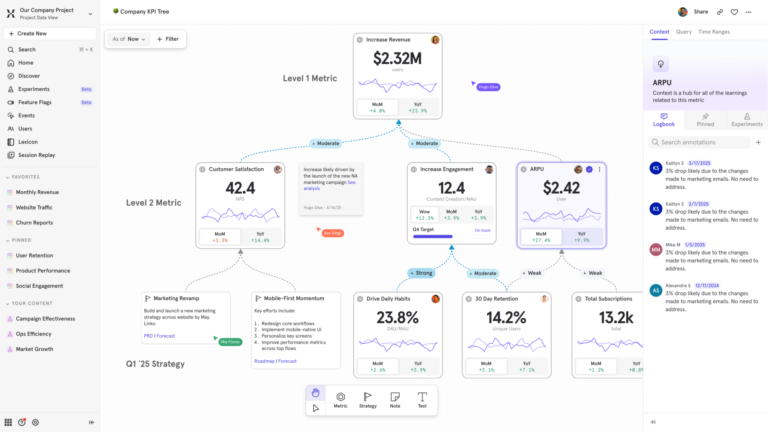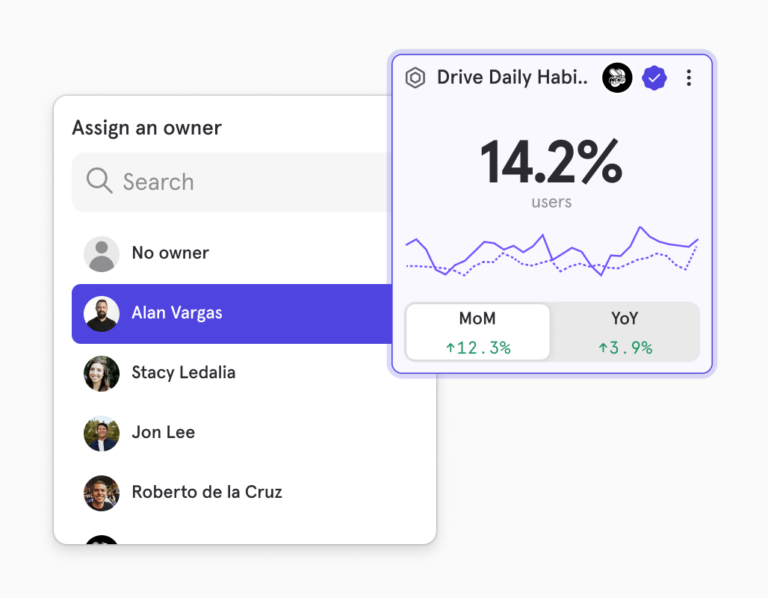
10 Metric Trees benefits you didn’t know about

Sometimes, innovation requires some explaining. When Mixpanel was building Metric Trees—a new way to bring clarity, alignment, and strategic traceability to your priority metrics—some customers understood it immediately. But others had questions:
- “What exactly can you do with Metric Trees?”
- “How do they differ from a dashboard or a canvas?”
They’re valid things to ask; and the idea of visually structuring your metrics, and then layering analysis and actionability on top, is something we think is unique in our space. But as customers found, there’s a lot of unexpected ways Metric Trees can help your team.

Let’s look at 10 of the metric tree benefits to give you an idea of what’s possible.
1. Visualize how metrics relate and drive impact
A Metric Tree immediately establishes a visual hierarchy of value. It maps out how granular input metrics (like feature usage, time spent in-app, or campaign performance) roll up and contribute proportionally to your high-level KPIs and, ultimately, your North Star metric.
For executives, this offers a single, clear view of the entire growth model. For teams, it ensures that every action is clearly linked to a business outcome, moving focus from isolated reports to system-wide impact.
2. Assign clear ownership and accountability
In complex organizations, metrics often float between teams, leading to situations where no one is truly accountable for monitoring or improving them. A Metric Tree solves this by allowing every single metric card to have a designated owner. This clarity accelerates decision-making and ensures that when a metric moves, the responsible party is instantly identified and empowered to take action, closing the loop between data insight and operational response.

3. Connect metrics to experiments and deep dives
A Metric Tree is an operational hub, not just a static map. You can link any metric card directly to the real-time Mixpanel reports, boards, and experiments. This means when a metric changes, analysts and product managers can jump right from a metric to deeper analysis. So, if you see a metric go up or down, you can immediately start exploring the why behind performance shifts.
"Strategy is a living and iterative process whose success can often only be measured based on lagging metrics. Metric Trees is the solution—it enables teams to understand how their leading indicators are performing and make adjustments so they can stay on track to reach their business goals.”
4. Surface data and relational gaps
The process of building a Metric Tree serves as a powerful strategic alignment exercise. When mapping the drivers of your North Star, teams often realize that key behavioral inputs (the "hidden variables" they hypothesize drive conversion) aren’t currently being measured. This process helps show your teams where gaps exist in your growth chain—either in what is being measured, or in cause-effect. From here, you can prioritize the new instrumentation needed, ensuring your data strategy is always proactively supporting your business goals.
5. Log actions and build institutional memory
The context of why a metric moved is as important as the movement itself. With Mixpanel Metric Trees you can annotate metrics with notes, decisions, and keep a searchable log of actions taken in response to metric changes. This institutional memory is vital for onboarding, auditing, and building organizational trust in the data, preventing future teams from repeating previous mistakes or wasting time investigating solved problems.
6. Adapt and evolve as strategy changes
A business strategy is a living document, and the data architecture must follow suit. Metric Trees in Mixpanel are interactive enabling you to:
- Mass edit (move entire sections of a tree when necessary)
- Add and remove metrics
- View updates in real time for those who have access
Compare that to using static diagrams and whiteboards like Figma or Miro, which are disconnected from your analytics, and it’s a clunkier workflow altogether.
Furthermore, since Metric Trees are designed as living frameworks, it’s best to review and update them regularly (e.g., quarterly). This process ensures that as new products launch, priorities shift, or old initiatives are retired, your single source of truth for growth remains current and aligned with the present reality of the business.
“Your operational model can't be a static artifact. It has to be a living system. A value framework like a Metric Tree operationalizes your strategy, connecting it directly to the pulse of your business. It transforms your annual planning exercises into a continuous, data-driven conversation, ensuring your entire organization can pivot intelligently as market realities shift.”
7. Enable executive-level conversations
Metric Trees cut through the complexity of dashboards and raw data. By providing a clean, top-down view of performance, executives can instantly understand how high-level KPIs are performing relative to operational metrics, and which departments own which results. This single source of truth facilitates clear, strategic discussions at the leadership level without requiring specialized data knowledge or relying on analyst reports.

8. Act as a powerful tool for root cause analysis
When your North Star metric takes a dive, your first reaction might be to panic. Everyone scrambles through dashboards trying to find the one number that broke. A Metric Tree totally eliminates that panic.
Since the map shows exactly how everything is connected, you simply follow the drop-off down the branches until you pinpoint the exact feature or input metric that caused the issue. It turns a frantic search party into a structured investigation, helping you fix the real problem much faster.
9. Onboard new employees faster
Understanding a company's business model can often be the greatest hurdle for new employees. A Metric Tree provides a strategic blueprint of how the business operates, clearly connecting customer behavior to value creation, goals, and organizational structure. It connects inputs to outputs in one visual, dramatically accelerating the strategic learning curve for new hires and cross-functional partners alike.
10. Metric Trees uncover "hidden" growth levers
By visually modeling the entire system, a Metric Tree allows teams to identify metrics where an incremental change could lead to an outsized return on the North Star. Sometimes, the biggest opportunities are in overlooked areas—a low-level metric with a strong, but underappreciated, proportional impact on the overall KPI.
Using Mixpanel's comparisons and correlation tools directly on the Metric Tree enables you to spot these hidden growth levers and reallocate resources for maximum efficiency.
Turn your strategy into an operational growth engine
The difference between successful growth and stalled initiatives is often the clarity of your strategic model. Metric Trees move your growth strategy from a theoretical concept to a living, collaborative framework integrated with your real-time product data. This framework transforms planning from an annual exercise into a continuous, real-time feedback loop. When every team is aligned on the model, they can move with the speed, context, and confidence required to maximize growth.
Learn more about Metric Trees and request a demo today.


